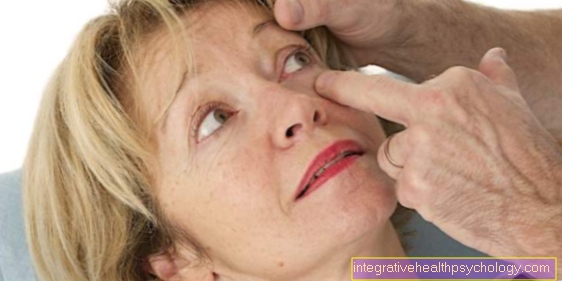Inner band knee
Synonyms
Medial collateral ligament, tibial collateral ligament, inner collateral ligament, inner knee ligament, medial collateral ligament (MCL)
General
The inner ligament of the knee is also known as the middle collateral ligament. It connects the thigh bone ("Femur") With the shin ("Tibia"). It is the central counterpart to the outer collateral ligament that connects the thigh to the fibula. Together they form the lateral stabilization of the knee joint.

Inner ligament anatomy
The ligamentum collaterale tibiale runs flat and relatively broadly spread out on the inside of the knee (medial) along with it slightly backwards (dorsal) is relocated. From the middle of the body (proximal) seen the inner ligament of the knee originates at the Medialis femoris epicondyle (inner protrusion of the thigh bone), pulls over the joint space and finally sits slightly below the Tibial condyle (medial condyle of the tibia) on the so-called Facies medialis tibiae at.
The MCL has a front (anterior) and a rear (posterior) Proportion, whereby a total of three fiber groups can be differentiated.
- the anterior long fibers run from the attachment point on the thigh to the attachment surface on the inner tibia
- the posterior upper short fibers pull towards the medial meniscus (Medial meniscus) and have grown together with it
- the posterior lower long fibers in turn run from the inner meniscus to the attachment surface on the tibia
This fusion with the outer joint capsule of the knee gives the middle side additional stability.
The two lower fiber parts of the inner ligament on the knee are from the Pes anserinus superficialis covered. About this fan-shaped union of the three muscles M. semitendinosus (Hemi-tendon muscle), M. sartorius (Tailor muscle) and M. gracilis (Slender muscle) attach these to the medial tibiae condyle. Between the pes anserinus and the inner ligament is the Bursa anserina (Bursa) and serves to move the three muscles in relation to the ligament.
Due to this close spatial relationship, depending on the load, inflammation of the bursa can (Anserine bursitis) come.
Read more on this topic at: Internal knee pain.
Function of the inner ligament on the knee
The inner ligament of the knee has the same function towards the middle of the body as the outer ligament towards the outside. If that Leg straight is, are both Collateral ligaments tense and prevent or reduce rotational movement in the knee joint. By increasing flexion In the knee joint, the radius of curvature is also reduced. Thus, the two starting points of the thigh and the shin come closer together, which is one Relaxation of the two collateral ligaments has the consequence.
The inner ligament of the knee in particular stabilizes the knee joint in the frontal plane (i.e. in the lateral direction) and thus prevents a X-leg position (Genu valgum).
In addition to stabilizing in the lateral direction, the inner ligament of the knee is also on Decelerating an external rotation in the Knee joint involved.
Pain in the inner ligament
If there is pain in the Inside of the knee is an acute occurrence as a direct consequence of a injury Differentiate (“trauma”) from permanent pain after long-term stress or damage to the affected structures.
The form of the pain and the circumstances under which the pain is noticeable also differ significantly. A very common reason for non-acute pain is a excessive or incorrect load when moving. For example, if you perform a monotonous movement incorrectly or significantly more strongly or more frequently than usual, this can initially lead to irritation.
A case in point is being overzealous in a new sport. to jog roughly is predestined for improper loading and excessive strain with long-term damage to the knee joint.
Pain in the course of trauma is different in nature. You kick at the moment of the accident stabbing on. Within a very short time, pain develops immediately above the pressure and movement Inner band of the knee and, in many cases, imagines Joint effusion with swelling, redness, pain and other signs of local inflammation.
In these cases anything can be done by one slight strain up to the rupture of the inner ligament, and you should immediately elevate the affected area, cool it, protect it and if possible one Printing compound invest.
Overstretching of the inner ligament
A Overstretching of the inner ligament of the knee is synonymous with a strain. Overstretching of the inner ligament as well as the Outer band occur more and more in sports medicine, especially in Skiers and Footballers, but also with other athletes.
A kinking or dislocation of the knee can be the cause, but above all a so-called "Rotational trauma“Is often the cause. Especially with skiers, where the heavy skis are firmly attached to the lower leg, it can become too light when the force is applied excessive rotations in the knee joint come.
The pain that occurs is acute and sharp. The knee joint only loses its stability insignificantly because the ligament only overstretched is. Immediately after such an injury, it is recommended to immediately relieve the leg and prevent swelling. To do this, the leg is raised so that more blood does not flow to the affected area.In addition, the area is cooled and a pressure bandage should be applied as soon as possible to counteract any swelling.
With rest and immobilization of the pulled inner ligament of the knee, overstretching usually heals within about two weeks off again. If this is not the case and if no doctor has been consulted by then, a consultation for further diagnostics is urgently recommended.
Inner ligament tear
With a particularly strong impact on the Inner band can stretch the ligament instead of overstretching it, too tear or tear off completely. One speaks of one Rupture the middle ("medial") collateral ligament. The pain is very similar to that of an acute strain. But there is also one lateral instability in the knee jointthat a trained doctor can diagnose with a flick of the wrist. In this case, the knee can be easily "opened" inwards.
If this suspicion is confirmed, a more precise diagnosis is required before starting therapy. A Arthroscopy of the knee would come into question here, but this is preferred in the event of damage to the Cruciate ligaments carried out.
MRI of the knee
A recording by a MRI of the knee shows the condition of soft tissue particularly well. It is a particularly precise method of diagnosis, but it is also an expensive one. A complete rupture of the inner ligament of the knee can therefore be easily recognized in any case.
therapy
Immediately after the knee injury, the first thing to do is to follow the so-called "RICE protocol" be taken to heart. RICE stands for the English words for Protection, cooling, compression and elevation.
If a strain or a non-serious case is one Inner ligament rupture is available, one will usually help conservative therapy. The focus here is on protecting and restricting any movement that involves the inner band.
Bandages, bandages, or splints can help, depending on the severity of the injury. If you rest for a longer period of time, there is also the fact that after the injury has healed Reconstruction of the regional muscles is necessary, among other things for prophylactic reasons.
For more severe ruptures, a surgery necessary, in which the tape is sewn and fixed at the original attachment points.
Taping
In the case of minor injuries to the inner ligament of the knee, but also as a preventive measure among athletes, the so-called "Taping" More and more popular.
This is a duct tapewhich is not elastic and is stuck to the skin. It stabilizes the joints during movements, it protects against overstretching and acts as a Compression bandage. Taping should be done by a doctor himself or under the guidance of such a doctor.
forecast
In the event of injuries on Inner band the prognosis is very good. Within less weeks there should be no restriction of movement. Sprains can be fine within two weeks heal, whereas with ruptures one heals from healing times up to 8 weeks goes out.
This prognosis only applies if only the inner ligament is affected is.










.jpg)




.jpg)







.jpg)
.jpg)




